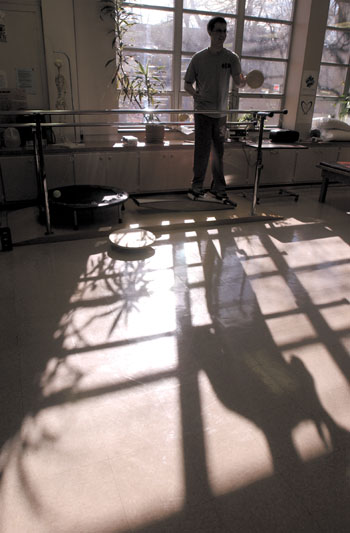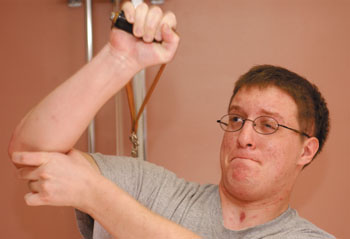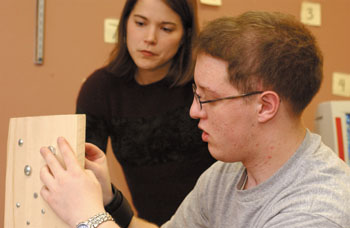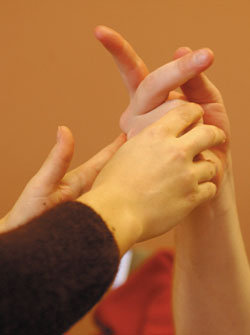
Jacob Grays shadow looms large before him as he undergoes physical therapy to recover from a traumatic brain injury.(photos by Dana Johnson)
Jacob’s ladder — One man’s recovery from traumatic brain injury a dance familiar to his therapists


Under the care and guidance of speech, physical and occupational therapists, Jacob pulls himself through recovery by flexing his muscles and his mind several hours a week.

Turning a nut off of a bolt loosens Jacob’s muscles and tunes his motor skills, says occupational therapist Marty Hubbard.

Manual labor strengthens Jacob’s right hand.
In a physical therapy room at the Pi Beta Phi Rehabilitation Institute, Jacob Gray slides from side to side on a platform affixed to a rocker, like swaying port to starboard on a rolling ship deck, as a therapist tosses him a ball. It’s therapy to teach his body how to balance again, but it could just as well be performance art, a dance illustrating the reversal of this young man’s life.
Until recently, Jacob, who turns 19 on March 31, stepped with his face to the sun, and all that lay before him was bright and warm. But today, a low winter sun casts from behind him a shadowy partner in his new dance. Dark and looming, long and attached, the shadow mimes his movements, lilts in deference to the backlighting sun.
Jacob Gray, Mr. Tullahoma High School, 2001, had a free ride on academic scholarships at the University of Tennessee at Chattanooga. He wanted to be a doctor. In the late afternoon on Oct. 19, hours after taking his first midterm exams, Jacob was back home, cruising down Normandy Road in a 1964 Mustang he rebuilt. He pulled out to pass, or to impress, a girl, but a car appeared in his lane. He swerved, and a tree got in the way.
“Jacob almost moved on to the next life,” his mother, Fran Gray, says.
He had a closed-head injury; the left side of his brain beaten by repeated hits to the inside of his skull. LifeFlight picked him up from the local hospital and brought him to Vanderbilt—Middle Tennessee’s only level-one trauma center. A coma seized his consciousness for three weeks. He lost the use of his left eye and, consequently, his depth perception. More seriously, the injured brain cells no longer communicated with the muscles along his right side to make them move properly. He teetered, dragged his right foot, held his right arm protectively close, and he fumbled—not only his hands, but his speech, his thoughts.
After almost a month in Vanderbilt University Hospital, and another month of inpatient rehab at Vanderbilt Stallworth Rehabilitation Hospital, Jacob moved on to the Pi Beta Phi Rehabilitation Institute at the Vanderbilt Bill Wilkerson Center for Otolaryngology and Communication Sciences.
The rehabilitation institute was named in honor of the Pi Beta Phi Alumnae Club of Nashville. The Alumnae Club has donated almost $3 million over the past 40 years through their major fund-raising event, Christmas Village. Ties to the sorority go back to the early days of the center, when Bill Wilkerson’s sisters, Nancy Fawn Wilkerson Diehl and Jane Wilkerson Yount, were active Pi Phis at Vanderbilt, and enlisted their sorority sisters to help make therapy aids for the patients as a community service.
“When we developed Pi Beta Phi Rehab in 1987, there was nothing like it in Nashville,” says Fred Bess, Ph.D., chair of the department of Hearing & Speech Sciences and associate director of the Vanderbilt Bill Wilkerson Center for Otolaryngology and Communication Sciences. “Clients left the hospital setting still needing a community-based program where function transitions to work, school and independent activities could be provided. This program was created to bridge that gap.”
Today, the institute is one of two in Tennessee certified by CARF, the Rehabilitation Accreditation Commission for outpatient brain injury rehabilitation. It helps people recover from brain injuries resulting from trauma, stroke or brain tumors, as young as age 11 and well into adulthood. Aside from traditional therapy, the institute also offers driving training and evaluation, “homebound” school that brings teachers from the Metro Davidson County school system to the institute, and speech pathologists who specialize in reducing non-English accents for people trying to assimilate to the Nashville community.
But Jacob represents the signature Pi Beta Phi Rehab patient, with typical symptoms; namely, he wasn’t quite himself any more.
“The challenges for a person with a brain injury is that they awake to a different self,” says Patsy Allen, a speech-language pathologist and director of Pi Beta Phi Rehab.
Jacob was a straight-A student who never had to try very hard to get the grades. The accident resulted in “shear injuries” to his brain cells, under his skull and the ear-to-ear scar on his head, says his physical therapist, Ann Shafer, and changes in his cognition. “You can’t just identify the area (of damage) by scars,” she says.
Physical, cognitive and emotional challenges resulting from the random disconnection of neurons creates what Allen calls the “Swiss cheese” effect.
“The holes in abilities are scattered,” she says. Memory deficits make once routine tasks foreign, and cognitive deficits make relearning everyday functional activities—driving a car, shopping for groceries, working, going to school—monumental each time they’re attempted.
Pi Beta Phi Rehab fills in the holes by having a virtual variety pack of therapists, all experts at helping the patient face the challenges of recovery. The goal for every patient, Allen says, is to regain independence.
When Jacob began therapy, “He wasn’t as present as he is now,” Shafer says. “He was talking a good bit, but what he said was not always appropriate to what we were doing. He didn’t have an awareness of his problems. ‘Everything’s fine,’ he’d say. He didn’t have any problems.”
Several hours a week, Jacob sits in Allison Gardner’s office, for mental workouts. “We’re not focused on his word sounds, but on getting the brain to work again, on his memory, attention and learning,” says Gardner, a speech-language pathologist who leads Jacob’s team of therapists. “When you’re working with someone who has suffered a brain injury, you have to break down any significant task into parts, and determine what the demands are on memory, learning and attention to do them. We try to give him what he needs to get on with life. He’s a very bright guy. He never had to study and prepare for the fact that life might be more difficult.”
Now, Jacob has to try. In a conversation, he has to try to pay attention so he contributes to the topic. When being taught, he has to try to focus on the lesson. But he can’t even depend on trying—he has to remind himself to try, by taking notes, making lists, keeping a calendar. This means teaching his brain new ways to get from point A to point B, by taking new neurological pathways, creating and using new circuits to make up for the ones that were damaged or the ones sheared away.
Gardner shakes up a Boggle game and wooden dice with letters on them jumble and settle at random. She and Jacob start writing words from the letters; three minutes later they compare their list. Jacob came up with “geo,” “got,” “gov” and “chess.” Gardner wrote down nine words. On another try, Jacob gets “sag,” “pip,” “sip,” “hip,” and “cab.” Gardner has those, and about 14 more. She explains that he could have written more words, if he’d only changed the order of the letters, but he can’t seem to wrap his mind around the concept.
The game exercises “flexible thinking,” Gardner says, to re-route the pathways. But it also helps diminish the lack of awareness, so he’ll learn that he has to pay attention differently, “so when he goes into a class some day he’ll know that, based on his past experiences, he’ll take notes, or use a tape recorder, or he depends on an organizer,” Gardner says. “My goal is for him to be independent.”
It’s slow and steady, yet Gardner’s therapy is tough — physically, mentally and, she says, emotionally. It wears on the pride.
But if Jacob weren’t a strapping lad, or if he didn’t have much mental wherewithal, he’d have his personality. Throughout his recovery, he’s maintained a sense of humor bordering jocularity. His sincerity makes you wonder if he’s really part of today’s disengaged generation. He’ll say, “You have a great day, now. And try to do your best, whatever you do.” And he’s just as happy to keep his pride in his back pocket. He easily jokes about the jumbled words that spill out of his mouth, and he shrugs off baking a chocolate mocha swirl cheesecake.
After Shafer works his legs, arms and balance, and after Gardner takes her turn with the bigger picture of putting life together, occupational therapist Marty Hubbard goes to work on his fingers, stretching the limits of his fine motor skills. He prints the alphabet, and Hubbard scores its legibility. It’s pretty sloppy, but Jacob shrugs. “It was pretty sloppy before my accident, too,” he says. He fits a socket onto a wrench, shaking a little, but it goes on. But pulling it off is like pulling apart a stick of butter, his right hand lacks the strength to grip it properly. So he uses a fold of his pants to grab hold, pulls it apart and lets out a big sigh.
“Performing functional tasks with his right hand is the most frustrating thing he does,” Hubbard says.
Jacob’s right hand is weak. His right arm also shakes a little, a development he’s tried to compensate for. But Hubbard is intent on correcting the problems, not covering them up, and everything they do has a lesson. Grocery shopping and baking incorporate “functional memory, how well he plans and organizes,” Hubbard says.
Soon, Jacob would like to get behind the wheel again. Hubbard’s working up to this slowly, taking him for drives to test his visual perceptual skills, testing how well he sees with his right eye.
Yet another aspect of Jacob’s therapy involves neuropsychologist Candy Burger, Ph.D., whose fundamental role is to interpret, for his family and for clinicians, the relationship between Jacob’s injury and his behavior, and how his behavioral changes are influencing his cognitive challenges.
“For individuals with brain injuries, the behavioral and social challenges are often the ones that prevent them from reintegrating into society,” Allen says. “If you ask a person with a traumatic brain injury, a severe one, five or 10 years after their accident what they are most bothered by, they will tell you they don’t have friends.”
Social skills normally learned through years of development are wiped away. “They don’t pick up on gestures, they don’t understand humor in the same way, it’s difficult to learn slang, so they’re perceived as just not with it,” Allen says. “That’s the way our society is. If someone is different, we tend to isolate them.”
Burger works with the therapists and Jacob to equip him for re-entering the real world by working on those societal rules. And with Jacob’s family she discusses the emotional impact of his injury and recovery. “It’s like the grieving process, because there was a loss here,” Fran Gray says. “We’re trying to get Jacob back into life, knowing that he’s not the same, we’re not the same…Working with the neuropsychologist has helped us with the change, going from what was to what is.”
Despite his amiable manner, Jacob has felt sadness, bitterness even, at his own loss—of functional ability and the time the accident took away from. And then there are times when the past few months seem like years added to his young life.
“I’m 18,” Jacob says. Then he adds, “On my birthday, I’ll be 25.”













